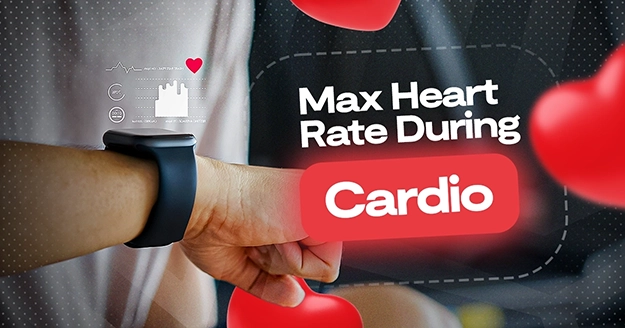Cardiovascular exercise refers to any vigorous activity that elevates heart rate (HR) and breathing, leading to increased oxygen and blood flow throughout your body. When it comes to cardio, maximum heart rate (MHR) is like your compass, guiding you through the twists and turns of your fitness journey, no matter what your fitness level is.
Define Maximum Heart Rate (MHR)
Maximum Heart Rate (MHR) refers to the highest number of bpm or beats per minute that your heart can reach during intense physical activity. It measures how fast your heart can beat to deliver oxygen-rich blood to your muscles during intense exercise. Various factors, including age, fitness level, genetics, and overall health, influence MHR. Understanding your maximum heart rate is vital for setting appropriate exercise intensities, monitoring fitness progress, and ensuring safe and effective workouts.
Benefits of Knowing Your MHR
Understanding your Maximum Heart Rate (MHR) can offer several benefits in your fitness journey:
- Optimizing Exercise Intensity: Knowing your MHR allows you to gauge the appropriate intensity level for your workouts. By staying within recommended heart rate zones based on your MHR, you can ensure that you’re pushing yourself enough to see results without risking injury.
- Setting Target Zones: With knowledge of your MHR, you can establish target heart rate zones for different types of exercises. These target zones help you tailor your workouts to achieve specific goals, whether it’s improving endurance, burning fat, or increasing cardiovascular fitness.
- Monitoring Progress: Tracking changes in your heart rate during exercise can provide insights into your fitness progress over time. As your cardio fitness improves, you may notice that you can sustain higher intensities while keeping your heart rate within a safe range.
- Preventing Overtraining: Exceeding your max heart rate during cardio can lead to overtraining, fatigue, and potential injury. By staying within your target heart rate zones, based on your MHR, you can avoid pushing yourself too hard and ensure a more balanced and sustainable approach to exercise.
- Enhancing Safety: When doing exercises such as cardio maximum heart rate is essential for exercising safely, especially if you have underlying health conditions. By staying within recommended heart rate zones, you can minimize the risk of complications and ensure that your workouts are both effective and safe.
Overall, knowing your MHR provides valuable guidance for optimizing exercise intensity, setting goals, tracking progress, preventing overtraining, and exercising safely, ultimately helping you achieve better results in your fitness journey.
How to Calculate MHR or Maximum Heart Rate
You can estimate your MHR based on age. To estimate your maximum age-related HR, subtract your age from 220. For example, for a 30-year-old person, the estimated maximum age-related HR would be calculated as 220 – 30 years = 190 beats per minute (bpm).
How to Calculate Your THR or Target Heart Rate
- For moderate-intensity physical activities, your THR should be between 64% and 76% of your MHR. Since a 30-year-old has an MHR of 190 bpm, the calculation of 64% and 76% would look like this:
64% level
190 x 0.64 = 122 bpm, and
76% level
190 x 0.76 = 144 bpm
Moderate-intensity physical activity for a 30-year-old person will require the heart rate to remain between 122 and 144 bpm during physical activity.
- For vigorous-intensity physical activities, your THR should be between 77% and 93% of your maximum heart rate. For instance, since a 30-year-old has an MHR of 190 bpm, the calculation of 77% and 93% levels would look like this:
77% level
190 x 0.77 = 146 bpm, and
93% level
190 x 0.93 = 177 bpm
This shows that vigorous-intensity physical activity for a 30-year-old will require the heart rate to remain between 146 and 177 bpm during physical activity.
Percent (%) of Your Maximum Heart Rate Chart
| ZONE | % OF MAX HR | EXERTION LEVEL | FITNESS GOAL |
| 5 | 90-100% | MAX | Fit athletes can improve sprint speed by training in short, intense bursts, which stimulates the development of fast-twitch muscle fibers. |
| 4 | 80-90% | HARD | This level of training can raise the anaerobic threshold and maximum capacity for shorter efforts. |
| 3 | 70-80% | MODERATE | Improve aerobic fitness and muscle strength. |
| 2 | 60-70% | LIGHT | Develop basic endurance that promotes fat burning and sustains performance during prolonged physical activity. |
| 1 | 50-60% | VERY LIGHT | Warm-up, cool down, and active recovery. |
| 0 | <50% | REST | No significant strain on the body. |
If you’re doing cardio, this cardio max heart rate chart might help you.
| Age | Cardio Max Heart Rate | Target Heart Rate |
| 20 | 100-170 | 200 |
| 25 | 98-166 | 195 |
| 30 | 95-162 | 190 |
| 35 | 93-157 | 185 |
| 40 | 90-153 | 180 |
| 45 | 88-149 | 175 |
| 50 | 85-145 | 170 |
| 55 | 83-140 | 165 |
| 60 | 80-135 | 160 |
| 65 | 77-132 | 155 |
Note that this max cardio heart rate chart works best with those who don’t have heart conditions or high blood pressure issues.
Factors That Affect MHR
While many formulas provide a rough estimate of Maximum Heart Rate (MHR) based on age and gender, determining MHR is more intricate. Several factors can influence your MHR, including:
- Age: Maximum Heart Rate (MHR) typically decreases as you get older.
- Altitude: Being at a higher altitude can lower your Maximum Heart Rate.
- Fitness: Maximum Heart Rate is not directly correlated with your level of physical fitness.
- Genes: Your genetic makeup influences your Maximum Heart Rate.
- Individual differences: Maximum Heart Rate can vary significantly among individuals of the same age and gender.
- Size: Maximum Heart Rate tends to be higher in smaller individuals, which is why women often have a higher MHR than men.
- Exercise: While regular training may not significantly alter your Maximum Heart Rate, any changes that do occur could result from increased blood and heart volumes over time.
How long can you stay at your MHR?
Your maximum heart rate represents the peak of your body’s physical effort, achievable only for brief intervals. For most people, this time frame typically ranges from about 10 seconds to a minute. Exceptional athletes may be able to sustain their maximum heart rate for up to two minutes, with others possibly extending this to 3-4 minutes.
However, it’s vital to listen to your body and not push yourself beyond your limits, as sustaining a maximum heart rate for an extended period can cause fatigue and potential health risks.
Does max heart rate increase with fitness?
Your maximum heart rate isn’t a direct measure of your fitness level, and it doesn’t necessarily increase with regular exercise or improved fitness. Having a higher maximum heart rate than someone else doesn’t mean you’re fitter than them. However, as your fitness improves, you may find that you’re able to sustain your maximum heart rate for longer durations.








